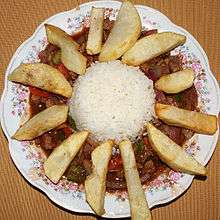Lomo saltado
.jpg)
Lomo saltado is a popular, traditional Peruvian dish, a stir fry that typically combines marinated strips of sirloin (or other beef steak) with onions, tomatoes, french fries, and other ingredients; and is typically served with rice. The dish originated as part of the chifa tradition, the Chinese cuisine of Peru, though its popularity has made it part of the mainstream culture.[1]
The dish is normally prepared by marinating sirloin strips in vinegar, soy sauce and spices, and stir frying these with red onions, parsley, tomatoes, and possibly other ingredients. The use of both potatoes (which originated in Peru) and rice (which originated in Asia) as starches are typical of the cultural blending that the dish represents.[2] [3] [4]
In his 2013 article in the Huffington Post UK, British-Peruvian chef Martin Morales called lomo saltado "one of Peru's most loved dishes" and that this dish "shows the rich fusion of old and new worlds. This juicy mixture of beef, onions, tomatoes, amarillo chilli and soy sauce sauteed in a large pan (or wok) is one of the many contributions Chinese immigration brought to Peru." He explains, "Lomo Saltado is sometimes known as a Criollo dish but more known as a Peruvian-Chinese dish; a favourite Chifa dish. These are its true roots." [5]
According to a 2011 article that was published in the Peruvian newspaper El Comercio, the book “Diccionario de la Gastronomía Peruana Tradicional” published in 2009 by Sergio Zapata Acha, includes an old description for lomo saltado, which fails to mention its Asian influence. Although this doesn't deny the dish's widely accepted Chinese-Peruvian roots, the article's author then ponders possible relations to similar dishes like lomo de vaca and lomo a la chorrillana.[1]
The word saltado means stir fry, a widely recognized Chinese cooking technique. Hence, saltado dishes are commonly known in Peru to have a Chinese cuisine influence. The same 2011 newspaper article mentions that having a Chinese cook (or servant) was considered a luxury at the time, and that years later after completing their indenture contracts, many Chinese Peruvians opened restaurants that became known as Chifa by 1921. A census of Lima in 1613 show the presence of Chinese (and other Asians) in Peru, mainly servants (and slaves). Later, large numbers of Chinese immigrant workers arrived between 1849 and 1874, to replace African slave laborers, while Peru was in the process of abolishing slavery. So it's not a surprise that a 1903 Peruvian cookbook ("Nuevo Manual de Cocina a la Criolla") included a short description of lomo saltado. An indication of assimilation of Chinese cooking technique in Peruvian cuisine. The culinary term saltado is unique to Peru, and didn't exist in other Latin countries of that era, nor used in any Spanish cuisine terminology. This old cookbook description of the dish is very short and doesn't mention soy sauce or other typical Asian ingredients of the dish we know today. It also doesn't mention black pepper, vinegar, or Peruvian chilies. A few critics incorrectly theorized a purely Peruvian origin (without foreign influence) based on this cookbook. Which features an assorted variety of regional Peruvian dishes (from Arequipa, Chorrillos, Moquegua, etc.). But this cookbook's list of traditional Peruvian Criollo cuisine includes many dishes with Spanish, Italian, Cuban, Guatemalan and Chilean origins. The 1903 cookbook is not an all inclusive list of old Peruvian dishes available in the country, and it doesn't contradict the Chinese-Peruvian roots of lomo saltado. It serves as an example (the opinions of its editor) of a variety of dishes that were commonplace in Peru of that era, regardless of origin.[6]

See also
References
- 1 2 Acosta González, Martín (29 May 2011). "La jugosa historia del lomo saltado, un plato fruto del mestizaje: Tal como lo conocemos hoy, se trata de un plato relativamente joven que vio la luz gracias a la fusión de sabores de la cocina peruana y china" [The juicy story lomo saltado, a dish result of crossbreeding: As we know it today, it is a relatively young dish which was created by the fusion of flavors of Peruvian and Chinese Cuisines]. El Comercio (Peru) (in Spanish).
- ↑ "Peruvian Lomo Saltado". Allrecipes. Retrieved 2008-07-26.
- ↑ "Lomo Saltado". Peru Mucho Gusto. Retrieved 2009-04-16.
- ↑ "Lomo Saltado Peruano" (in Spanish). Comedera.Com. Retrieved 2013-09-24.
- ↑ Morales, Martin (May 4, 2013). "Peru's Lomo Saltado on BBC TV: A Homage to Our Jumping Peruvian Beef Stir Fry". Huffington Post UK.
- ↑ Ledesma, S.E., ed. (1903). Nuevo Manual de Cocina a la Criolla (in Spanish). p. 18.
